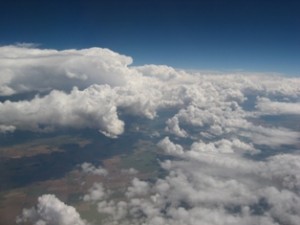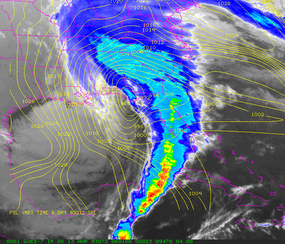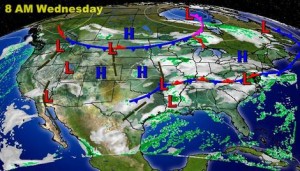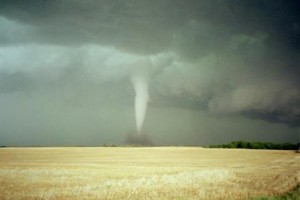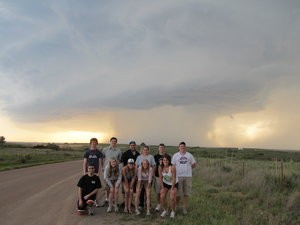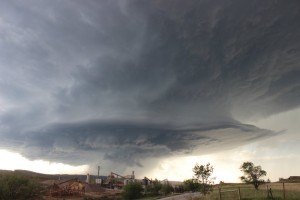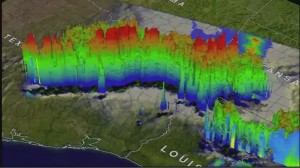Below is a list of courses I regularly teach. Please note that not every course is offered every semester and that I do not necessarily teach a course every time it is taught. “Syllabus” at the beginning of each course description links to a pdf version of the syllabus from the last time *I* taught the course.
ATMS-100/GEOG-100: An Introduction to Meteorology
Credits: 3; Satisfies Physical Science and Quantitative Reasoning II
Prerequisites: None
Lecture Meeting Times: M W, 10:00-10:50 Lincoln Hall Theatre
Lab Meeting Times: Th OR F in G8A Foreign Languages Building (15 sections)
Textbook: Essentials of Meteorology by C. Donald Ahrens
Syllabus: This course introduces students to the essential concepts and principles of meteorology with emphasis on the interpretation of weather maps and charts. By the end of the semester, students will be able to interpret and develop basic weather forecasts as well
as explain basic atmospheric phenomena, including mid-latitude weather systems, warm
and cold fronts, hurricanes, thunderstorms, tornadoes, blizzards, ice storms, clouds and precipitation processes, daily and annual temperature cycles, and climate change. Questions will be presented in laboratory sections and on tests that stress critical thinking. Success in this class comes through understanding concepts, not memorizing facts.
ATMS-303: Synoptic-Dynamic Weather Analysis
Credits: 4 (offered every fall semester)
Prerequisites: ATMS-201; concurrent enrollment in MATH-241
Meeting Times: T Th 2:00-3:20 109 Atmospheric Sciences; F 10:00-10:50 G27 FLB
Textbook: Midlatitude Synoptic Meteorology by Gary Lackmann
Syllabus: In the first portion of this course, we examine weather observations in detail, including surface METAR observations, soundings, and satellite imagery. We also learn how to understand and interpret weather maps, with a specific focus on identifying surface fronts and on upper-air maps. In the second portion of this course, we expand upon our interpretation of weather maps and charts to include an in-depth examination of synoptic-scale cyclones and anticyclones. Using our analysis of weather maps as a guide (and some mathematics, including quasi-geostrophic theory), we investigate the atmospheric processes that lead to the genesis, intensification, and decay of these systems. While lectures and lab assignments emphasize the analysis and interpretation of weather maps, some topics are also developed from a theoretical (i.e., mathematical) perspective. Students are expected to apply this material on lab assignments and exams.
ATMS-313: Synoptic Weather Forecasting
Credits: 4 (offered every spring semester)
Prerequisites: ATMS-303 (no exceptions will be granted)
Meeting Times: T Th 2:00-3:20 109 Atmospheric Sciences; F 10:00-10:50 G27 FLB
Textbook: Midlatitude Synoptic Meteorology by Gary Lackmann
Syllabus: Now it’s finally time to learn how to forecast the weather! During this course, students learn the basics of numerical modeling, how models are used to predict the weather, and how to apply various forecasting techniques (including statistical methods) to forecast many different aspects of the weather, including high and low temperatures, precipitation amounts, precipitation types, sky cover, wind speed and direction, visibility, thunderstorms, and severe weather. We also complete our study of synoptic meteorology, covering fronts and frontogenesis, Q-vectors, and isentropic analysis. Although forecasting methods will be presented in class, it is important to remember that there is no one way to forecast the weather, and that the only way to truly learn how to forecast is by actually making forecasts. As such, forecasting is a major component of class homework assignments, especially during the second two-thirds of the semester.
ATMS-314: Mesoscale Dynamics
Credits: 3 (offered every spring semester)
Prerequisites: ATMS-301, ATMS-302, ATMS-303
Meeting Times: M W F, 1:00-1:50, 109 Atmospheric Sciences
Textbook: Mesoscale Meteorology in Midlatitudes by Paul Markowski and Yvette Richardson
Syllabus: This course provides an in-depth examination of atmospheric processes that occur on the mesoscale (roughly between 1-100 km in scale). Our study of these phenomena will be both qualitative (e.g., through map analyses and case studies) and quantitative (e.g., through mathematical calculations and derivations) in order to demonstrate the linkage between observed mesoscale processes and their theoretical and dynamical foundations. We begin by formally defining the mesoscale (it does not only include thunderstorms and severe weather!) and by reviewing essential concepts from thermodynamics and dynamics as well as sounding and radar analysis techniques. Mesoscale processes and phenomena covered in this course include mesoscale instabilities, boundary layer processes, lake-effect convection, the nocturnal low-level jet, mesoscale boundaries, mountain and gravity waves, and deep moist convection (convection initiation, ordinary convection, multicellular convection, mesoscale convective systems, supercellular convection) and its associated hazards (tornadoes, damaging winds, hail, flash floods).
ATMS-324: Field Studies of Convection
Credits: 2 (offered twice every summer I semester)
Prerequisites: ATMS-201
Meeting Times: Varies
Textbook: None
Syllabus: This course allows students to directly forecast, nowcast, and observe deep moist atmospheric convection and its associated phenomena. Since weather patterns are not fixed, the most efficient way to observe this convection is to travel to where it is most likely, which is a function of the large-scale weather pattern. Students are expected to actively participate in daily morning and evening weather forecast discussions, during which our destination for the day and our plan of travel for the coming days is determined. Other educational activities, such as visits to research labs like the National Severe Storms Laboratory or the National Center for Atmospheric Research, National Weather Service Forecast Offices, the Atmospheric Radiation Measurement site, or other similar activities, may be conducted at the discretion of the instructor if it is determined that the trip is unlikely to observe atmospheric convection on a particular day. All students are required to participate in all activities and are expected to have at least a basic knowledge of weather analysis and forecasting and of the structure and behavior of various modes of atmospheric convection before enrolling in this course. Following the return from the trip, all students are expected to give a 15-minute oral presentation about one specific date from the trip, including routing and navigation, types of convection observed (including photographs), forecast skill and verification, and what they learned. Due to the inherent variability and unpredictability of the weather, there is no guarantee that any particular type of weather will be observed. Prior to departure, all students will be required to sign a liability release approved by the Office of Risk Management. Course includes a mandatory course fee of $1300.
ATMS-491: Atmospheric Convection
Credits: 3 (offered every other fall)
Prerequisites: ATMS-301 AND ATMS-302 OR graduate standing
Meeting Times: M W F, 11:30-12:20, 109 Atmospheric Sciences
Textbook: Atmospheric Convection by Kerry Emanuel
Syllabus: This course provides a rigorous examination of atmospheric convection. Our investigation of convective processes will be both qualitative and quantitative to stress the linkage between convection as observed in the real atmosphere and its theory and governing dynamics. We will begin by formally defining convection (it is not just a synonym for thunderstorms!) and by reviewing select topics from traditional dynamics and thermodynamics courses. Topics to be covered in this course include the buoyancy force, the Boussinesq and anelastic approximations, local convection, boundary layers and Rayleigh-Benard convection, cumulus clouds and entrainment, convective storm environments, ordinary (single-cell) convection, multicellular convection, mesoscale convective systems, supercelluluar convection, tornadoes, and numerical simulations of deep moist convection.
ATMS-491: Advanced Forecasting
Credits: 3 (offered every other fall)
Prerequisites: ATMS-313 or graduate standing
Meeting Times: T Th, 9:30-10:50, 109 Atmospheric Sciences
Textbook: None
Syllabus: In this course, we will build upon our knowledge of synoptic weather forecasting to include advanced and mesoscale forecasting concepts. Topics to be covered include tropical weather forecasting, severe weather forecasting, aviation, fog, and visibility forecasting, aircraft icing, marine forecasting, and other topics as determined by the instructor and the prevailing weather patterns. Emphasis will also be placed on the proper and clear communication of weather forecasts to the intended audience.
ATMS-505: Weather Systems
Credits: 4 (offered every spring)
Prerequisites: Graduate standing or permission of instructor
Meeting Times: T Th, 3:30-4:50, 109 Atmospheric Sciences
Textbook: Midlatitude Synoptic Meteorology by Gary Lackmann
Syllabus: This course provides students with both a theoretical and observational survey of midlatitude weather systems. The first half of this course focuses on synoptic-scale cyclones. Topics covered include weather map analysis, thermal wind, quasi-geostrophic theory, ageostrophic circulations, frontogenesis, baroclinic instability, and cyclogenesis. In the second half of this course, we apply what we learned in the first half of the course to weather forecasting, including winter storms, temperature and precipitation forecasting, ensemble forecasting, severe weather forecasting, and weather communication. The last two weeks of the course will include a rigorous examination of deep moist convection. Many topics will be introduced through class lecture and discussion and students will be expected to develop an understanding of these topics via analysis of the weather outside of class (including participating in the WxChallenge forecasting contest), class assignments, and exam preparation.


